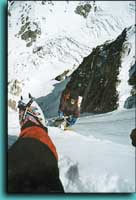Andrei Volkov and Victor Kolesnichenko joined the expedition when most of work on the
route was already done. This circumstance produced a kind of a psychological strain. The
same circumstance gave them a chance to test the fashionable "alpine style" of
high altitude climbing. Andrei's answer to the insistent questions regarding this theme
was abrupt: |

Victor Kolesnichenko is ascending to Andrei Volkov
|
|
"Frankly saying, when I was going to the base camp, I didn't care a damn what style
should I use for climbing. My only thought was whether the guys finish. If they did, my
chances to stay at the base camp for a long period would melt away every day. If people
are sitting at the base camp for two weeks because of you, no one on the route will feel
comfortable. This is obvious, and I clearly understood that Victor and I had a small
interval of time for attempts if guys already "made" the mountain. It didn't
matter anyway in what style I climbed, provided that it would be quick and without delay.
That is the first reason.
The second. I began to doubt it all: that term "alpine-style" has to be used
very correctly. Carlos is right. How can it be alpine style when the path has already been
cleared and resources are available (tents are placed, ropes are fixed etc.)? I'll speak
roughly: any fool can make use of an alpine style. You better go to a mountain where there
is nothing, but snow and ice. Just do it - climb it in the real "alpine-style"! |
Acclimatization is, as it were, provoking. Not to drag a tent down, so as to keep the
purity of style, but leave it above. To fix rope only once, and not to do it every time
when you ascend to the same place. But I profoundly doubt the alpine style via classic
routes. When I read in a magazine or in a book that a group summitted using alpine style,
it is necessary to examine carefully that they didn't ascend before to acclimatize or
whether there were not five expeditions before which left everything on the route. Carlos
told me the same. He accentuated many times that so called "small expedition" or
"light expedition" style is very deceptive. When a group of Sherpas is working,
when other people fix ropes you certainly can do something. That's all concerning alpine
style.
It's difficult to think of something new for high altitude climbing. There is always much
snow work on the eight-thousanders. You hardly can do it by yourself. It's even difficult
to ascend across snow country for two together. You have to replace each other often. The
light style increases the rate of climb, but acclimatization is setting its traps. If you
didn't get acclimatized, your organism simply doesn't work. You can bite through something
of yourself, but it doesn't work, your motor doesn't function, nothing moves, you take a
step and then breathe in and out twelve times, take one more step, and later it turns out
that you did nothing for three hours... Well, that's all. The nature puts a strict ban
there.
Certainly, there is another way. If only we went with acclimatization from any 7,000
meters peak. When we arrive - everything is ready, everything is known: ready, steady, go!
Yes, it is possible to get acclimatized in another place. But what's the point? You can
get acclimatization in the same place... That's what Krzysztof Wielicki did last year. He
descended from K2 and arrived to Nanga Parbat at once. There was some Poland expedition
working just before. It fixed all the ropes and left all the tents. They already finished
their work, and he at once, with no acclimatization rushed to the top. Under such
conditions the summit itself took five days... Well, our summit itself takes that much
too".
| |
|

